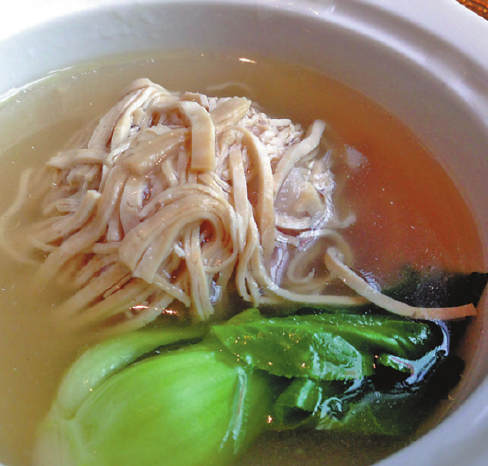
This tender meatball is shrouded in beancurd juliennes, adding to the illusion that it is a lion's head.[PAULINE D. LOH/CHINA DAILY]
Lengths of water Artemisia, stripped clean of any leaf, had been simply tossed with the little lake shrimps. This is my second day in Nanjing, and already my palate was luxuriating in the all-natural sweetness of Nature's bounty. The shrimps exploded in the mouth like puffs of sugar, and the vegetables added crunch that neither overcame nor was overwhelmed.
I am ashamed to say that though other dishes came in quick succession, my chopsticks kept going back to the luhao and shrimps. It was the only clean plate sent back to the kitchen that afternoon.
During our marketing, Meng had bought a curious bunch of vegetables that I thought had a familiar floral scent. He served this up next in a very light soup, and contrasted the dark deep green with an egg drop using only the white.
This is what the Nanjing folks call chrysanthemum leaves, and it is indeed a relative of the flowering variety. The very aromatic leaves had a pleasantly pungent scent and worked well as a palate cleanser after the intense pleasure of the shrimps.
Finally, the chefs presented a simple cake made from two types of rice flour, the usual white rice and darker, deeper purple rice. Again, subtlety is the key word, and the smidgen of lotus paste hidden in its heart was all that was needed to complete the epicurean treat.
In another meal in the same restaurant, executive chef Samson Sun, a native Beijinger, proudly showed off his skills with another dish-beaten eel.
Translated, the name of this dish loses much of its lyricism and acquires an unwarranted exoticism. In truth, eels are very commonly eaten here, and provide much of the protein in the diet.
They are plentiful, easily caught and raised and are another signature in the regional cuisine.
Beaten eel is a deboned fillet that is laid flat on the chopping board and beaten with a rolling pin to tenderize the flesh. The fillet is braised, mainly to get rid of the fishy taste. The result is a fish roll, tender at first bite, and then chewy when you reach the skin.
At Richesse Chinoise, the beaten eel is served with a dove egg, its white translucent and serving as a contrast to the eel's dark meat.
If you only had one chance to eat Chinese, search out Huaiyang cuisine. It combines the best of northern and southern styles and in Nanjing, few places serve it better than the Richesse Chinoise.
